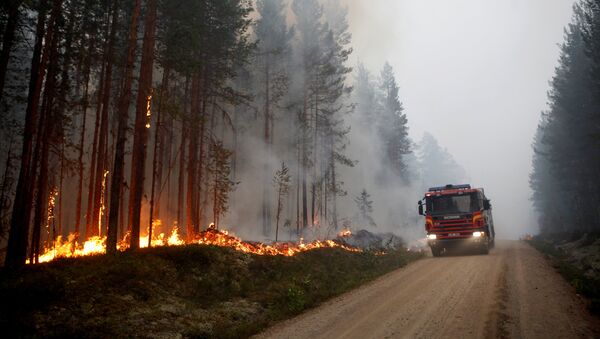A sizzling summer has followed a remarkably hot spring, sparking an abnormal number of forest fires across the Nordic country, which the Swedish Civil Contingencies Agency has described as the "most serious in modern times," national broadcaster SVT reported.
The roughly 80 fires currently harrowing Sweden have been attributed to an extremely unfortunate combination involving dry terrain, high temperatures and lack of frequent rain.
Earlier this year, Sweden, where snowfalls are not unthinkable even in late spring, experienced its hottest May on record, with temperatures reaching and exceeding 30 degrees. After a brief respite at the beginning of the summer, the heat returned in July, with temperatures rising above 30 degrees in many parts of the country, often for several days in a row.
TV►Se unika bilderna från de härjande skogsbränderna #skogsbrand #msb https://t.co/7u4HtcSd8C pic.twitter.com/w8cybHaLzX
— Helahälsingland (@Helahalsingland) July 17, 2018
To crown it all, the hot spell is coupled with an exceptional drought, which had created an "extreme risk" of forest fires as early as May. At present, the lack of rain is so bad that the governments in several Scandinavian countries are considering state assistance for struggling farmers.
Skogsbränder rasar över hela Sverige https://t.co/ZeBl8CMxxO pic.twitter.com/eq8MMUTLpC
— Svenska Dagbladet (@SvD) July 14, 2018
Many of the fires are believed to have been sparked by people using disposable barbecues despite the ban on any kind of open fire in the majority of municipalities at the moment.
Despite the unparalleled spread of forest fires stretching from the Baltic south to the Arctic north, the worst affected regions are all located in central Sweden — Gävleborg, Jämtland and Dalarna, where many locals have been evacuated. National forecaster SMHI warned of a risk for forest fires in virtually every municipality.
Not much left after the biggest forest fire in Sweden, but nature is recovering.#photography #travel #photooftheday #pentax #sweden #sverige #skogsbrand #forest #reborn #nature #main_vision #travelphotography #naturreservat #naturephotography #fantastic_earth pic.twitter.com/rECg40zHR8
— Gregor (@gregoralfaomega) June 24, 2018
To assist the firefighters, whose resources have been stretched thin, military personnel, volunteers and international assistance have all been summoned.
Two firefighting airplanes doing a great job to extinguish the forest fire at Nacka #skogsbrand #Nacka pic.twitter.com/Y8JiEuQfUM
— Wilco Schuttelaar (@WSchuttelaar) June 15, 2018
In Pålgård, Jämtland, over a hundred volunteers signed up to help the embattled local municipality. Meanwhile, assistance has also arrived from other countries. Norway contributed six helicopters to help extinguish blazes from above, whereas firefighting planes were called in from Italy.
Wildfire in Ängra, Gävleborg, Sweden. #wildfire #fire #ängra #skogsbrand pic.twitter.com/2wN03EAn5l
— Göran Strand (@Astrofotografen) July 15, 2018
According to the Samtiden news outlet, Sweden was much better prepared for stopping forest fires two decades ago. In 1995, Sweden was about to add "water-bombing" aircraft dubbed Skopan ("Scoop") to its firefighting arsenal, but the politicians said no, citing help from the EU that would come if necessary.
The decision to dismantle national firefighting forces has sparked criticism, with Expressen columnist Fredrik Sjöshult blaming the decision on "bureaucracy and dumb greed."
Twitter user Humanekot wondered why Russian help hadn't been sought given its proximity to Sweden and vast experience battling forest fires in the taiga.
Skogsbranden i Ängra, Ljusdals kommun#hemvärnet #Ljusdal #skogsbrand #räddningstjänstenljusdal #nofilter pic.twitter.com/OkfHCV8aln
— Stina Berg (@Stinisberg) July 16, 2018
Skogsbrand igår… korpen håller koll. #skogsbrand #raven pic.twitter.com/chujmmCAKQ
— karlslund (@pcd193) July 15, 2018


